Technical Information: What is Periomatic™? >JAPANESE
What is Periomatic™
Periomatic™ is a proprietary period-based frequency measurement technology developed by COCORESEARCH, a pioneer in this field.
It features Dynamic Prediction™ (hyperbolic prediction computation) and stop prediction capabilities,
enabling high-precision and rapid response across various scenarios, including start-up, shutdown,
ultra-low to high speeds, and sudden accelerations or decelerations.
Traditional Rotation Speed Measurement: Frequency-Based Approach
The conventional method counts the number of pulses within a gate time to determine frequency.
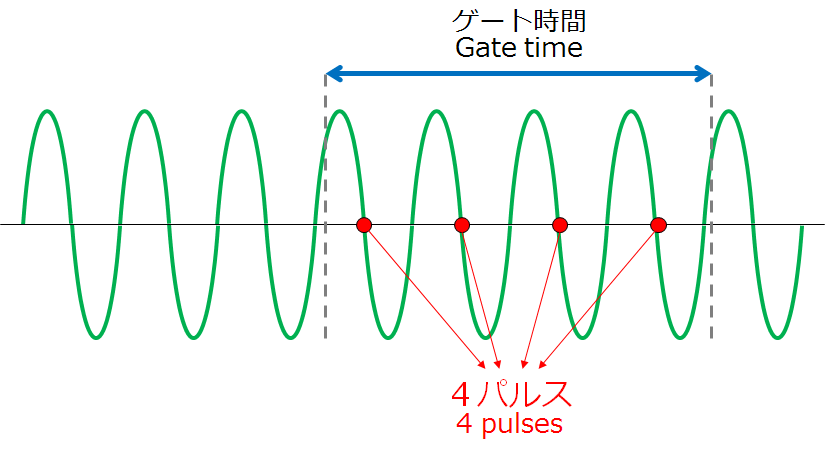
Issues with Frequency-Based Measurement
At low speeds, this method encounters several challenges:
■Response Limitation: Achieving a response faster than the gate time is not possible.■Accuracy Reduction: Shortening the gate time increases the impact of single-bit errors, leading to decreased measurement accuracy.
■Ripple Disturbances: Analog outputs suffer from ripple disturbances, causing waveform irregularities even with consistent pulse intervals, due to the timing of gate closures.
Example: No response per pulse.
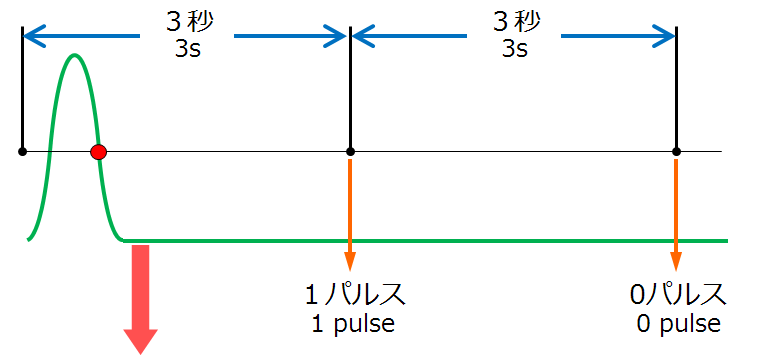
No more pulses are received after this, but you have to wait until the gate deadline.
Example: 1-bit error and ripple failure
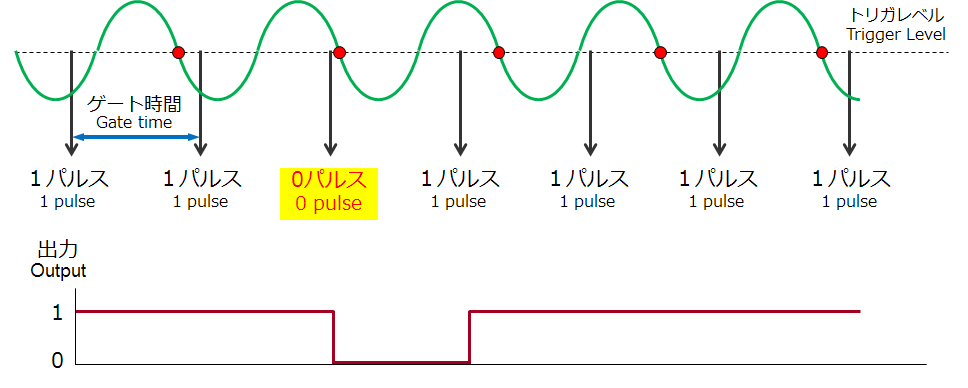
Ripple Failure: Disturbance of waveform is called ripple.
Even if pulses are input at a constant cycle, depending on the timing of the gate cutoff, the output will be disturbed.
For example, in low-speed rotations
■Low-speed rotations like wind turbines

→The system may fail to detect rotation, resulting in a zero output despite actual movement.
■Shield machine
- Machine length: approx. 9 m
- Gross weight: approx. 600t
- Excavation speed: approx. 7.5 m/day (when digging)
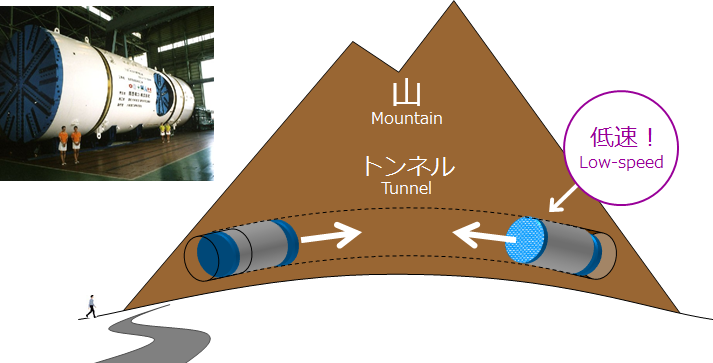
→If the rotational speed cannot be measured, the two shielded machines will not match.
Periomatic™: Period-Based Measurement
Periomatic™ measures frequency based on the period between pulses:

Rapid Response: Capable of responding to each cycle individually (in Mode A) or per gate cycle (in Mode B).
Error Minimization: Requires only two pulse inputs to determine the period, minimizing the impact of single-bit errors.
Elimination of Ripple Disturbances: This method inherently avoids ripple disturbances present in traditional frequency measurements.
Advantages of Periomatic™ Over Traditional Methods
| Traditional Gate Method | Periomatic™ Method |
| Response faster than the gate time is not possible. |
Enables response to each individual cycle. |
| Short gate times increase single-bit error impact, reducing accuracy. | Determining the period with just two pulses minimizes error impact. |
| Analog outputs suffer from ripple disturbances. | Eliminates ripple disturbances entirely. |
Relationship Between Frequency and Period
| As input frequency decreases, the period extends compared to the previous cycle, |
| ▼ |
| Leading to a reduced measurement output. |
| ▼ |
| Periomatic™ utilizes hyperbolic prediction computations to adjust the measurement output accordingly. |
Frequency (f) and period (T) have an inverse relationship: f = 1/T.
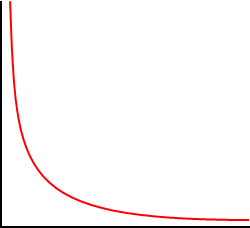 f=1/T
f=1/T
In Cartesian coordinates, this relationship forms a rectangular hyperbola.
Operation Example of the Periomatic™A method
Pulse input and F/V voltage output by the operation of the Periomatic™A method are shown below.
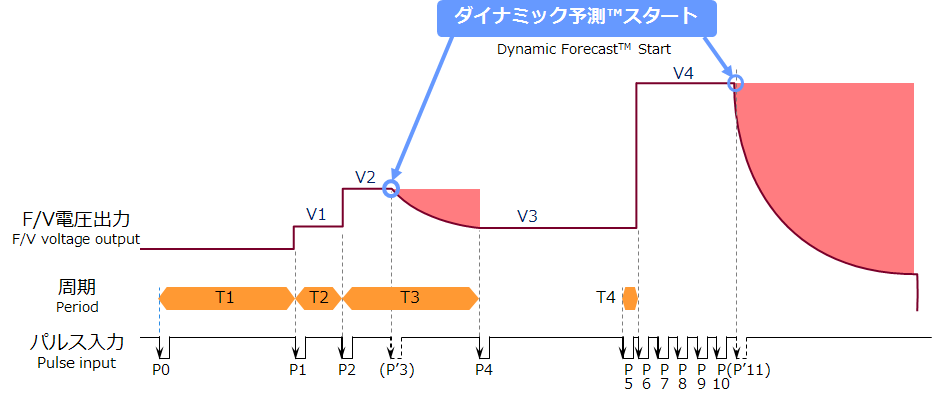
The pink area shows the difference with and without Dynamic Prediction™.
There is a big difference in the measurement results.
The *Periomatic™ B method also has a Dynamic Prediction™ function, which is updated every gate hour.
About the Periomatic™ B method
| Measures the number of input pulses between pulse signals and output update time as an internal gate |
| ▼ |
| Measure the number of pulses and the period of pulses, then find the sum of the periods and average them. |
| ▼ |
| Dividing the total period by the number of pulses |
| ▼ |
Enables measurement of the average period per pulse! |
Operation Example of the Periomatic™ B method:
Comparison with conventional gating methods
■Example 1: Gate time 1ms, input pulse 1.5kHz
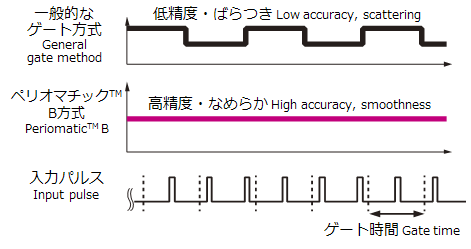
■Example 2: Input frequency fluctuates
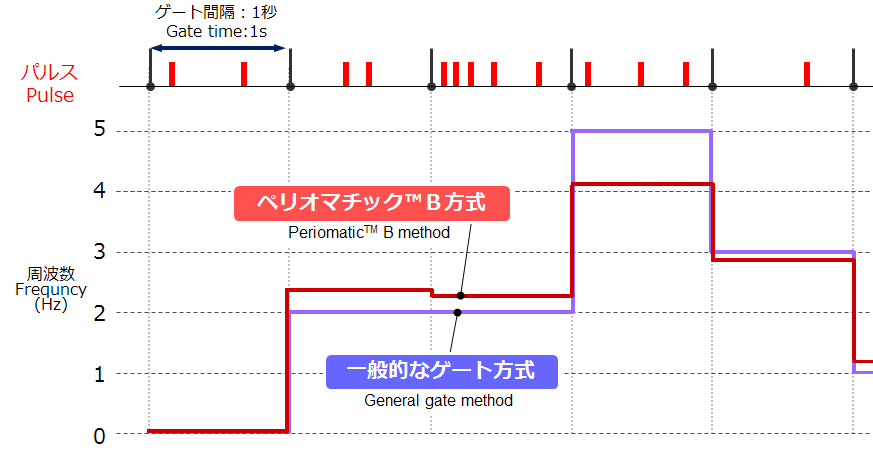
Summary: Periomatic™ Modes A and B
Periomatic™ is available in two types: Method A (response priority) and Method B (accuracy priority).
| Periomatic™ A: Unique one-pulse response | Periomatic™ B: Unique gating method |
E.g. of operation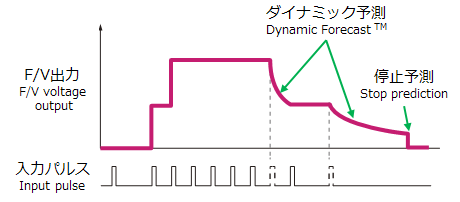 |
E.g. of operation |
| ■Wide range of measurement (from low to high speed) ■Highly resistant to ultra-low speeds ■High accuracy |
|
| ■High-speed response (single-pulse response possible) | ■Time averaging ■High accuracy can be obtained even in a short gate period. |
| ■Acceleration: High-speed response with 1-pulse response, high accuracy even for rapid acceleration ■Deceleration: Accurate prediction calculation by Dynamic Prediction™ (hyperbolic prediction calculation) ■Stopping: Predicts stopping at appropriate timing according to usage conditions |
■Precisely measures and averages the number of pulses and cycles within the gate time. ■No pulse count error within the gate time, which occurs in general gating methods, and high resistance to uneven pulses. ■Predictive calculation also works during deceleration, resulting in high accuracy and high speed response. |
The Periomatic™ method makes it possible to measure rotational speed in detail, and COCORESEARCH proposed the term "rotational analysis.
| > See F/V converter list | > See speedmeter list |
> To the page TOP
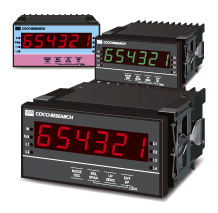 Speedmeters
Speedmeters F/V Converter
F/V Converter Handy Speedmeter/Counter
Handy Speedmeter/Counter Compact multi-CH measuring
Compact multi-CH measuring